Keeping in line with the dismal performance of Bollywood movies at the box office in the post pandemic era, both Aamir Khan and Akshay Kumar’s festive releases ‘Laal Singh Chaddha’ and ‘Raksha Bandhan’ opened to collections lower than expected. In fact, ‘Laal Singh Chaddha’ brought in the lowest collection for Aamir in 13 years! For Akshay, ‘Raksha Bandhan’ opened lower than ‘Samrat Prithviraj’ and ‘Bachchhan Paandey’.
Amid growing concern, the industry had hung its expectations on these two releases, hoping for the tide to change. As Suniel Shetty recently told ETimes, as much as Akshay and Aamir need for the film to do well at the box office, the industry too needs it. The recent crashes of films like ‘Shamshera’, ‘83’, ‘Jersey’, ‘Runway 34’, ‘Satyameva Jayate 2’, ‘Heropanti 2’ among others have been distressing. Star power, large scale mounting, backing of giant studios – the films had it all, yet they turned out to be box-office washouts.
Similar concerns led the Telugu film producers to stall film shoots from August 1 in a bid to ‘restructure the industry’. The production costs have mounted several folds whereas the theatrical revenues have dropped to unprecedented low levels. A correction was inevitable. From ticket pricing to OTT window, cost control to regulating the working hours, the producers body has been brainstorming on various aspects of filmmaking to optimise the business.
Speaking about the Telugu industry preparing for a correction, Akshay Kumar said to ETimes, “I believe they want to rectify this system of filmmaking. Since they have taken an initiative, I hope they can come up with the right solution and perhaps the Hindi film industry can do the same, so that things can settle down.”
Trade analyst Atul Mohan raises similar concerns and says correction is the need of the hour in Hindi film industry too. “It’s the only way to bail the industry out of crisis. Look at the dismal performance of releases from Jan-Feb onwards. Just a couple of films are turning out to be box office successes. We are still living in a fantasy world ignoring the reality around us. The Telugu producers have collectively come together and are working towards rectifying things. And I applaud their initiative,” he says.
This edition of #BigStory highlights perspectives from producers and trade experts about whether they feel a correction is overdue in Bollywood.
What changed the economics of filmmaking in India?
Until 2005, it was the independent producers who backed the Hindi movies. However, the dynamics changed with the advent of corporates like 20th Century Fox, Eros, UTV and other giants that had huge fundings. And then came the wave of OTT that paid ridiculous money to buy exclusive rights of movies. With money flowing in, the remunerations increased too. Sadly, neither did the corporates survive, nor are the OTT platforms willing to pay that kind of money anymore. To top that, footfalls in the cinemas are nowhere close to what they used to be in the pre-pandemic era.

Filmmaker Mukesh Bhatt believes that the problem is not just with the stars’ fees alone, but with the entire economics on which the film industry is operating today. “It’s all gone berserk as there is no reality check. The producers have paid such ridiculous fees to actors because they were getting ludicrous deals from the OTT platforms. Now that the OTT platforms have pulled the plug, the revenue source has gone. So now how are they going to pay? And nobody was concerned with making a movie, everybody was doing arithmetic and considering which star to cast so that the film can be sold to OTT and satellite and make big bucks. The best of people make the worst of mistakes. The time has come to correct the mistake. The stars don’t deserve the kind of money they are charging, because their films don’t have that kind of opening,” he says.
Producer Ratan Jain recalls, “Before 2005, I had never priced an actor above 2.5 crore, be it Shah Rukh Khan, Aamir Khan, Akshay Kumar, Ajay Devgn or any other actor. But after the corporates came in, the same price hiked to 20 crore, 25 crore, 50 crore, 100 crore…There was no regulation.”

Mukesh Bhatt agrees, “The corporates destroyed the industry by pumping huge amounts of money without any understanding of filmmaking. And now they have all shut down, so a correction is bound to happen. When you do business with wrong economics, then it cannot sustain. The independent producers became like white tigers. Because the independent producers and distributors didn’t have that kind of deep pockets to invest that kind of money.”
Should there be a fee correction for stars?
With the film business taking a hit due to the underwhelming performances of Hindi films at the box office, many believe A-list Bollywood stars should take responsibility and entertain pay cuts to ensure financially sound outcomes for films. Trade analyst Komal Nahta says, “Of course fee correction for actors should happen. Most of the time, 30-40 percent of the film’s production money goes to the stars. If these stars don’t become considerate, it’s detrimental to the growth of their own industry. One should not kill the hen that lays the golden eggs. So yes, both price correction and content correction should happen.”
Ratan Jain shares, “The star system existed since the 1960s. But back then, the actors’ fee was reasonable. It’s true the audience won’t go to watch a film without a star. There are very few films that work on their merit with a newcomer in the lead. So that star system will stay, and there is no problem with it. But if the stars become unreasonable, a producer may have to sell his house. Now some actors have started coming forward and becoming partners for films. But the share that they are asking for also needs to be considered. Some ask for 50 percent, some ask for 80 percent, some even ask for 90 percent share!”
Mukesh Bhatt believes we need a system where everybody should live and let live. “Actors can charge a reasonable price equivalent to what they command on the opening day. If the film works well, they can certainly take a backhand. But now if a movie doesn’t work, these actors are walking away with the money and the producer alone sits with liability. This isn’t fair,” he says.
Film distributor Raj Bansal opines the audience stopped going to the cinemas when they got the option of watching movies on OTT. “Besides, the quality of Hindi cinema has deteriorated. Most of the budget goes in the payments of big stars, so there’s hardly anything left to make the film. The producer has to make do in the remaining budget and compromise with the content. It’s time the actors and producers rethink the budgeting of films,” he says.
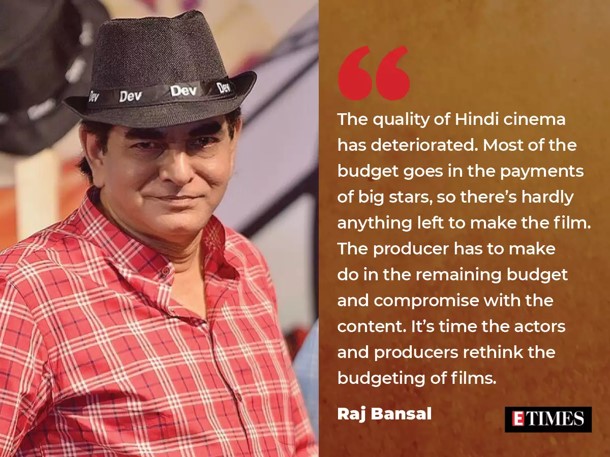
Akshay Kumar reflects on the idea and says, “A lot of people are bothered by the lack of big box office numbers and such people believe that things need to be changed. I have always believed that the monetary aspect of cinema should first be aimed at the film’s writer because he/she is the most important person on the project. The dialogue and script of a film are the most important aspect of filmmaking and yet, in our film industry, they’re still not given their due importance. The biggest heroes of our industry are our writers. If a writer cracks a story or a screenplay, no film can go wrong. Next in line of importance comes the director, then the technicians and finally actors.”

Filmmaker Dinesh Vijan says at his Maddock Films, they have always believed in backing writers and directors. “For us, content has been at the forefront of everything. We always feel that a film’s subject should define its budget. It is a given that an actor with his repertoire can increase that element, but the base decision of a film’s cost should be defined on how many people the subject will appeal to thereafter,” he says.
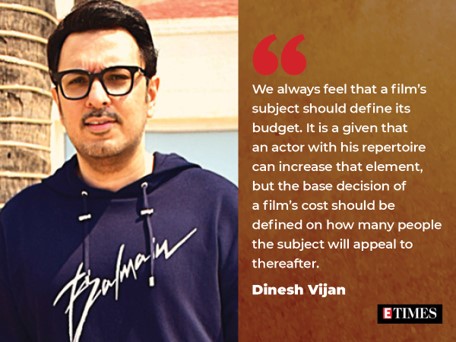
Media sector analyst Karan Taurani sheds light on the difference in fee structure in Bollywood and Hollywood, “If you consider a big budget Hindi film, almost 70 per cent of the cost is the talent cost which is very high. If you look at Hollywood, the talent cast is not that high. It is somewhere between 30-35 per cent. They are spending more on technology, VFX etc. The audience wants to watch larger than life kind of movies if they are paying to watch the film in theatres. So the economics have changed drastically. Producers and studios can always piggyback on digital rights and satellite rights because of which the negative impact of a film not doing well theatrically is kind of cushioned off. But this is also not sustainable because if you have back to back films failing at the box office, there will also be a correction in digital rights. This can have an impact on ROI.”
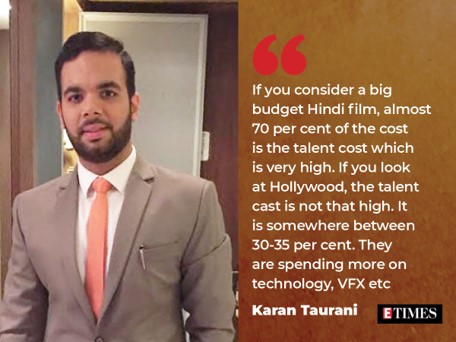
Another Bollywood producer on condition of anonymity said outright, “ Actors 10-20 crore kum karenge to kum loss hoga.”
Content correction can be a game changer
Industry veterans observe that the content in Hindi cinema has undergone a drastic change and certain elements that attracted footfalls in the theatres have been ignored by filmmakers lately. Apart from fee correction, they believe Bollywood also needs content correction that will bring the audience back to the cinemas.
“Slashing the fee is one thing, but we will also have to make good films,” says Ratan Jain. “There are hardly any writers with fresh original stories. We started assuming actor bada toh film badi. Nobody thinks about the story anymore. The music has been wiped out. Directors thought they could take the music out of Hindi films. Why do these big Telugu films with songs work even today? Music makes a big difference in promoting a movie and generating revenue too.”

Film producer NR Pachisia believes we need to reinvent ourselves. “This is an actor and technician driven industry who are all charging a bomb. But today, you need to start respecting a writer also. There is so much to write today for different platforms like OTT, YouTube, satellite, TV shows and motion pictures. Whether people agree or disagree, content is the king. We have to reinvent ourselves and we have to work very hard. And music is the key. Take ‘Sita Ramam’ for instance. It has extraordinary music. Talk about ‘Pushpa’, music makes all the difference. Even ‘RRR’ has great music. Music is the key to the success of any movie today,” he says.

Another Bollywood producer on condition of anonymity shares that filmmakers should choose the right genre for an actor. Citing some examples, he says, “Consider Shah Rukh Khan’s 2004 movies ‘Main Hoon Na’, ‘Veer Zaara’, and ‘Swades’. ‘Swades’ did not do great business, but the other two movies did. So, it’s not about the actor, it’s about the producer who decides what kind of film to make with an actor. ‘Darlings’ and ‘Gangubai Kathiawadi’ are classic examples. If you make ‘Darlings’ with Alia Bhatt, you cannot take it to theatres, but Alia could end up making more money with ‘Darlings’ because the cost is lower. For theatrical releases you have to make films that are exciting. You need bigger scale, larger than life action, big stars, comedy, music, romance and other such elements. Producers are going wrong with content selection. Theatrical releases should be more commercial like it used to be in the pre-multiplex era, before 2008 when single screens and two tier, three tier were contributing a lot. The same content appealing to these audiences is still working in theatres. OTT has brought everything for the audience to their homes during the pandemic. We have lost the cinema going audience. So producers have to let go of content driven, non-commercial films. Music has to be there and it has to be a multi-genre film.”
The bottomline
The existing formula of filmmaking is clearly not working in the post pandemic world, where the audience seems to be very selective of what content they want to watch in the cinemas, and on OTT. Bringing in a correction seems to be a way to bring the industry back on track. As Karan Taurani points out, this kind of correction has happened earlier as well. “This is a cyclical industry, so you see this time and again. New talent replaces old talent. Actors like Varun Dhawan, Ayushmann Khurrana, Kartik Aaryan used to work at a low cost earlier. Now their fee per film has also grown about 2-3 times in the last 3-4 years. Clearly they are the future and they are doing well. Once this happens, probably 3-4 years down the line there will be a new breed of stars who will work at a lower cost. The big stars then turn producers and co-producers,” he says.
Dinesh Vijan opines that everyone needs to have their skin in the game. “Everyone should be an active stakeholder rather than front load. Money must be spent on the actual production of the films that excite the audiences and bring them back to cinemas. That, I feel, is the most important thing to do,” he says.
Atul Mohan believes a lot of factors need to be corrected. “From writing to execution to star prices everything! The audience’s taste has evolved post pandemic. Stars should realise this and reconsider their remuneration. Stop living in a fantasy world and smell the coffee. If you are confident of a product then come as a partner in profits. Jeeyo aur jeene do, otherwise we all will be extinct,” he concludes.

















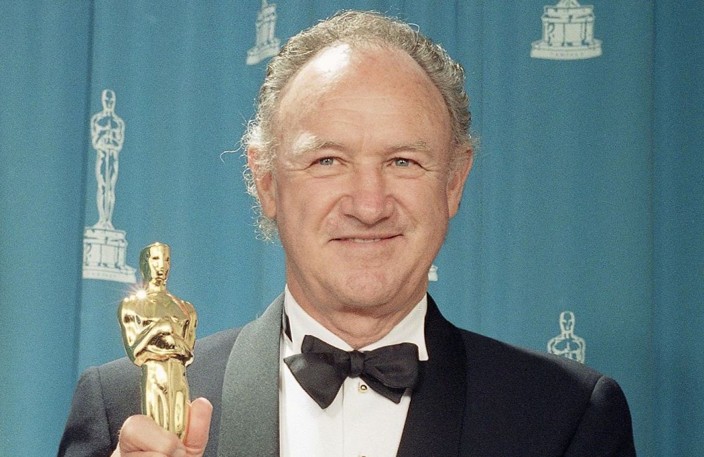
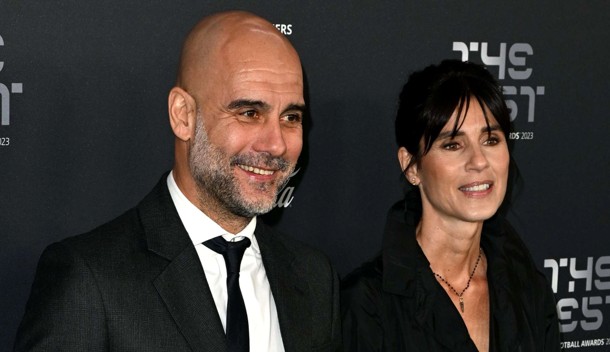





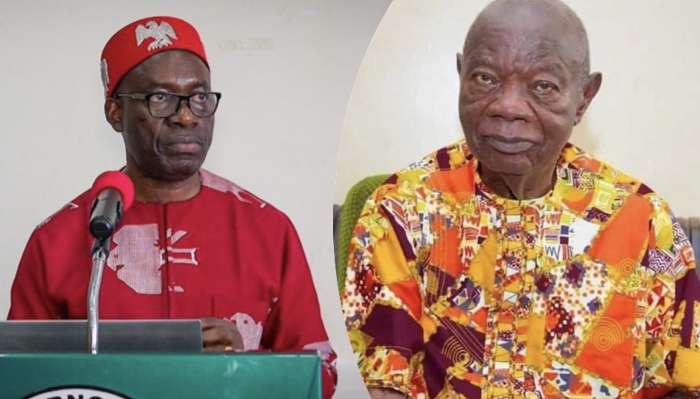



Leave a Reply